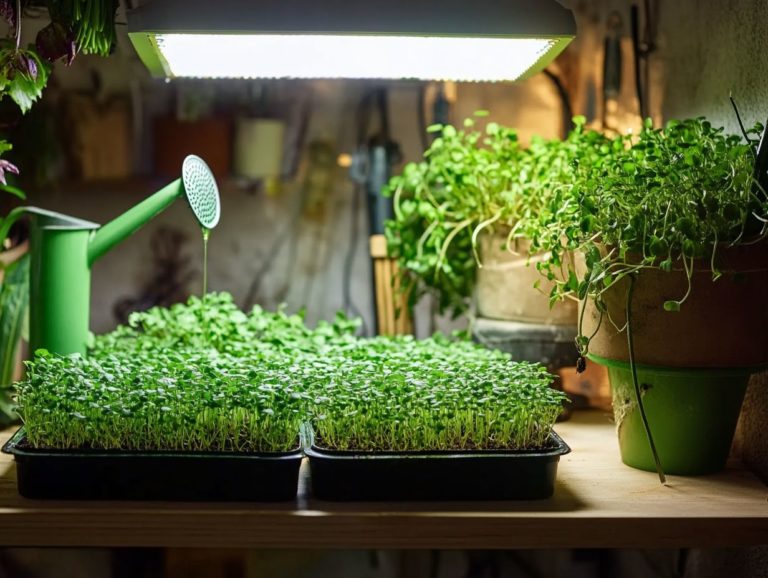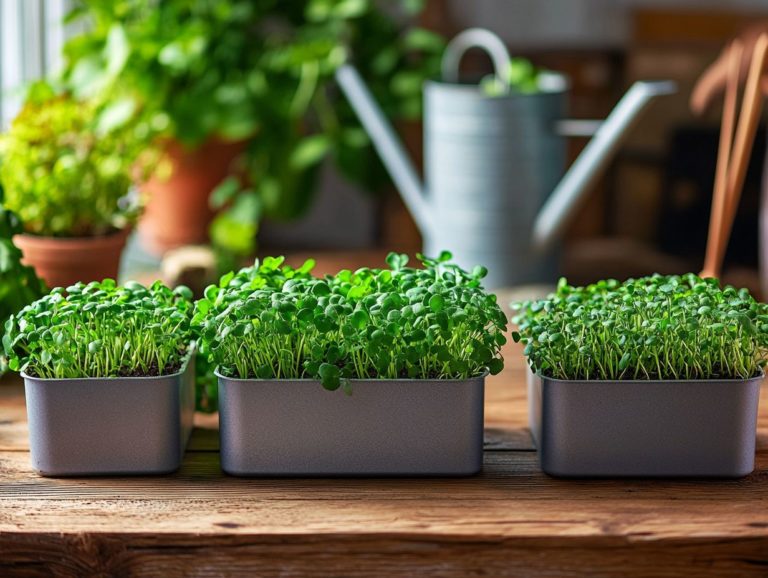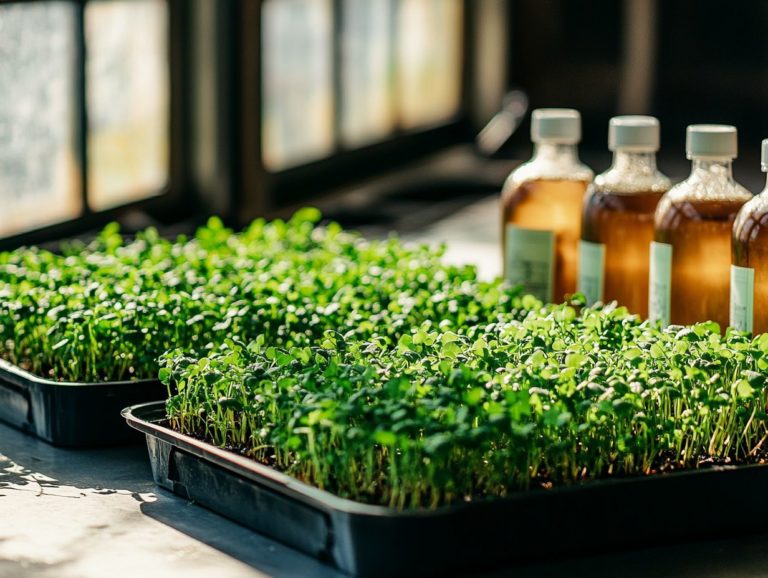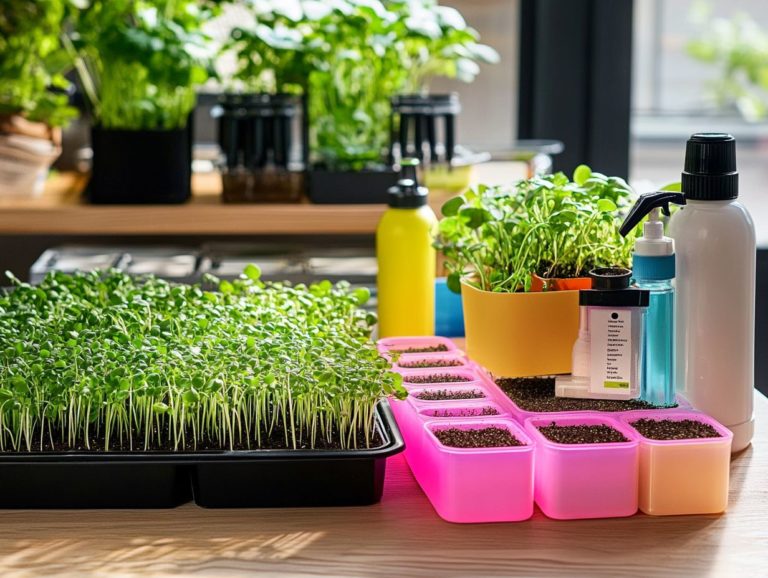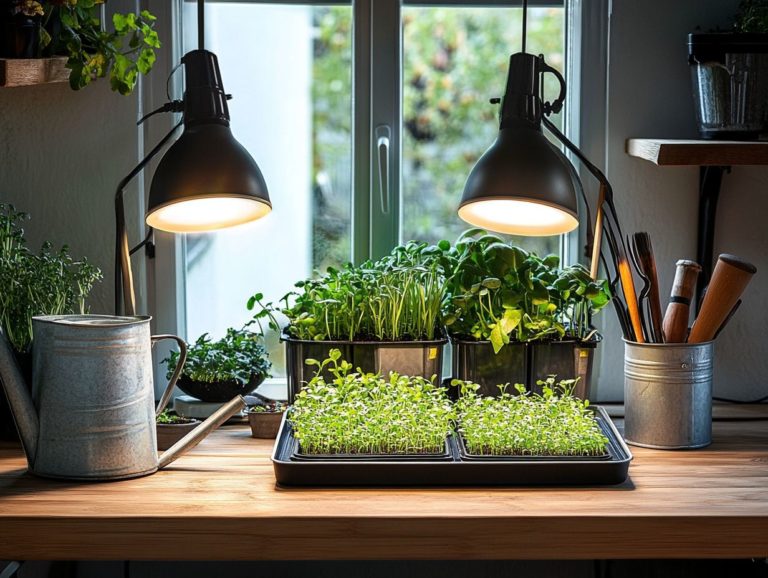How to Use Climate Control in Microgreen Growing
Microgreens have surged in popularity, celebrated for their vibrant flavors and impressive nutritional benefits. However, cultivating them successfully involves more than simply scattering seeds in soil.
One of the pivotal aspects of nurturing a lush and thriving crop is mastering effective climate control.
This article delves into the significance of managing temperature control, humidity, and light in microgreen cultivation. You ll explore indoor gardening and outdoor growing methods, uncover essential tools and techniques, and receive valuable tips for maintaining optimal growth conditions.
Best practices will be outlined to help you sidestep common pitfalls.
Immerse yourself in the captivating world of microgreens and learn how climate control can elevate your growing experience to new heights!
Contents
- Key Takeaways:
- Climate Control in Microgreen Growing
- Factors Affecting Climate in Microgreen Growing
- Methods for Controlling Climate in Microgreen Growing
- Tips for Successful Microgreen Growing with Climate Control
- Frequently Asked Questions
- What is climate control and why is it important for microgreen growing?
- How do I use climate control for my microgreen growing setup?
- What are the ideal climate conditions for microgreen growing?
- Can I use natural methods to control the climate for my microgreens?
- How can I troubleshoot climate control issues in my microgreen growing setup?
- Are there any advanced tools or techniques for climate control in microgreen growing?
Key Takeaways:
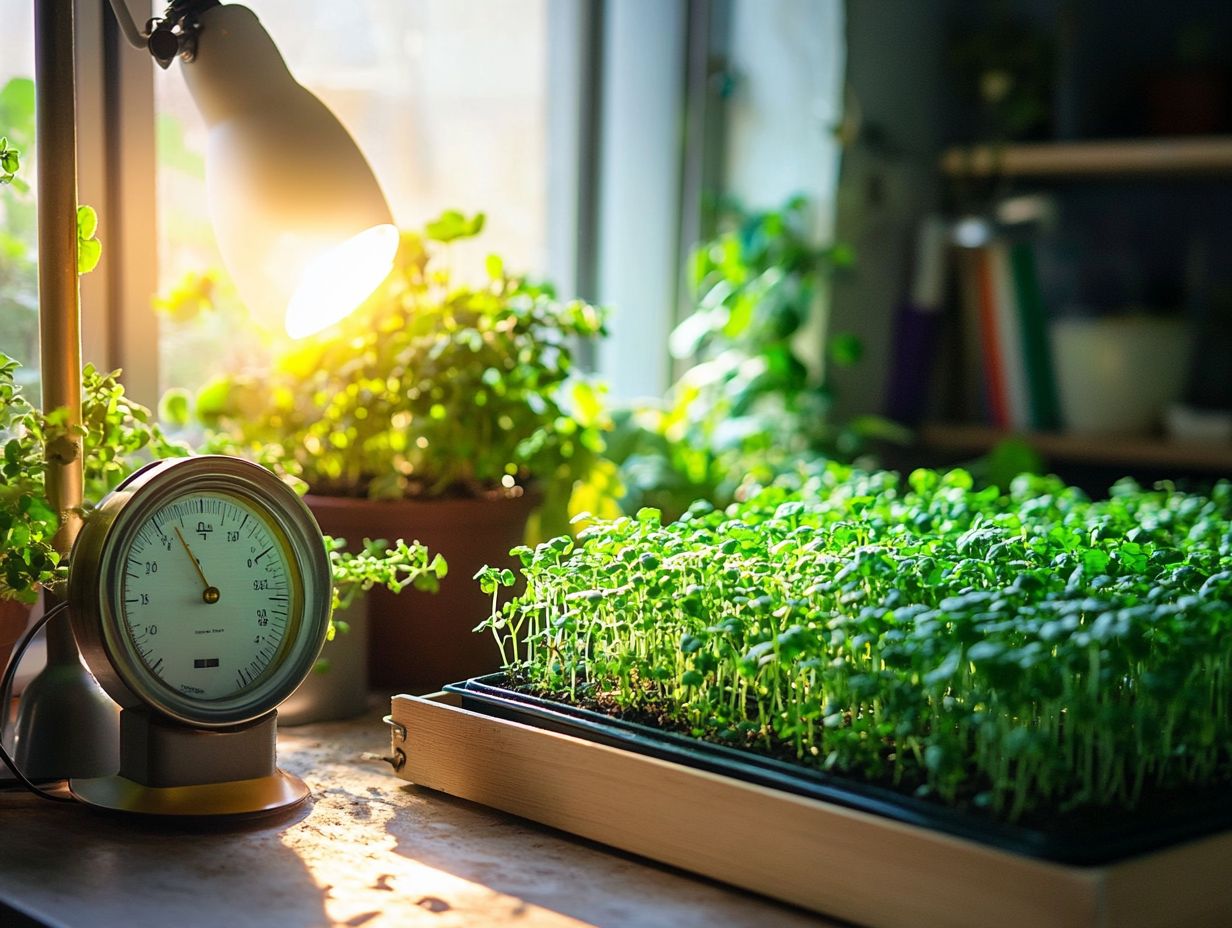
Maintaining the right climate is crucial for successful microgreen growing, as it directly affects their growth and nutrient absorption. Factors such as temperature, humidity, and light play key roles in controlling climate and must be carefully monitored and adjusted. Indoor growing with tools and techniques like grow lights and humidifiers can provide better climate control for microgreens.
What are Microgreens?
Microgreens are young, edible plants harvested just after germination, typically between 7 to 21 days. Bursting with flavor, color, and nutrients, these little wonders are grown from various vegetable seeds, including broccoli, radish, and basil. They thrive beautifully in many environments think indoor gardening setups like Hamama’s Seed Quilts.
These tiny greens are nutritional powerhouses, often boasting higher concentrations of vitamins and minerals than their mature counterparts. Popular varieties, such as pea shoots, arugula, and sunflower, bring distinct flavor profiles to your plate, ranging from the peppery kick of radish to the subtle sweetness of sunflower. This versatility makes them perfect for enhancing a variety of dishes.
Chefs can t get enough of microgreens! They incorporate them into salads, sandwiches, and garnishes; their vibrant colors and unique textures elevate aesthetic appeal and enhance the overall dining experience. With their easy cultivation and remarkable health benefits, microgreens are quickly establishing themselves as a staple in both home kitchens and professional culinary settings.
Climate Control in Microgreen Growing
Effective climate control plays a vital role in your microgreen growing journey. It directly impacts the health of your seedlings, their germination rates, and their ability to absorb nutrients.
By maintaining a carefully controlled environment particularly within the Hamama system you can create optimal growth conditions for a variety of microgreens. This holds true whether you’re cultivating in the humid embrace of Hawaii or the arid landscapes of Alaska.
Why is Climate Control Important?
Climate control is essential because it directly influences your microgreens’ germination rates, moisture levels, and overall plant health. This ultimately affects their nutrient content. By maintaining optimal growth conditions, you can ensure your microgreens thrive and develop desirable flavor profiles.
Temperature is also very important; warmer climates may speed up germination, but they can also lead to excess moisture loss, impacting the plants’ health and nutrient uptake.
Light exposure is critical for photosynthesis, which is the process plants use to make food from sunlight. Adequate air circulation helps mitigate disease while optimizing moisture retention, resulting in crops that are not only bursting with flavor but also rich in essential vitamins and minerals.
By grasping these climate-related factors, including humidity levels and air circulation, you can fine-tune your growing environment. This ensures that every batch of microgreens reaches its full potential.
Ready to grow your own microgreens? Start experimenting today and enjoy the benefits of this rewarding gardening endeavor!
Factors Affecting Climate in Microgreen Growing
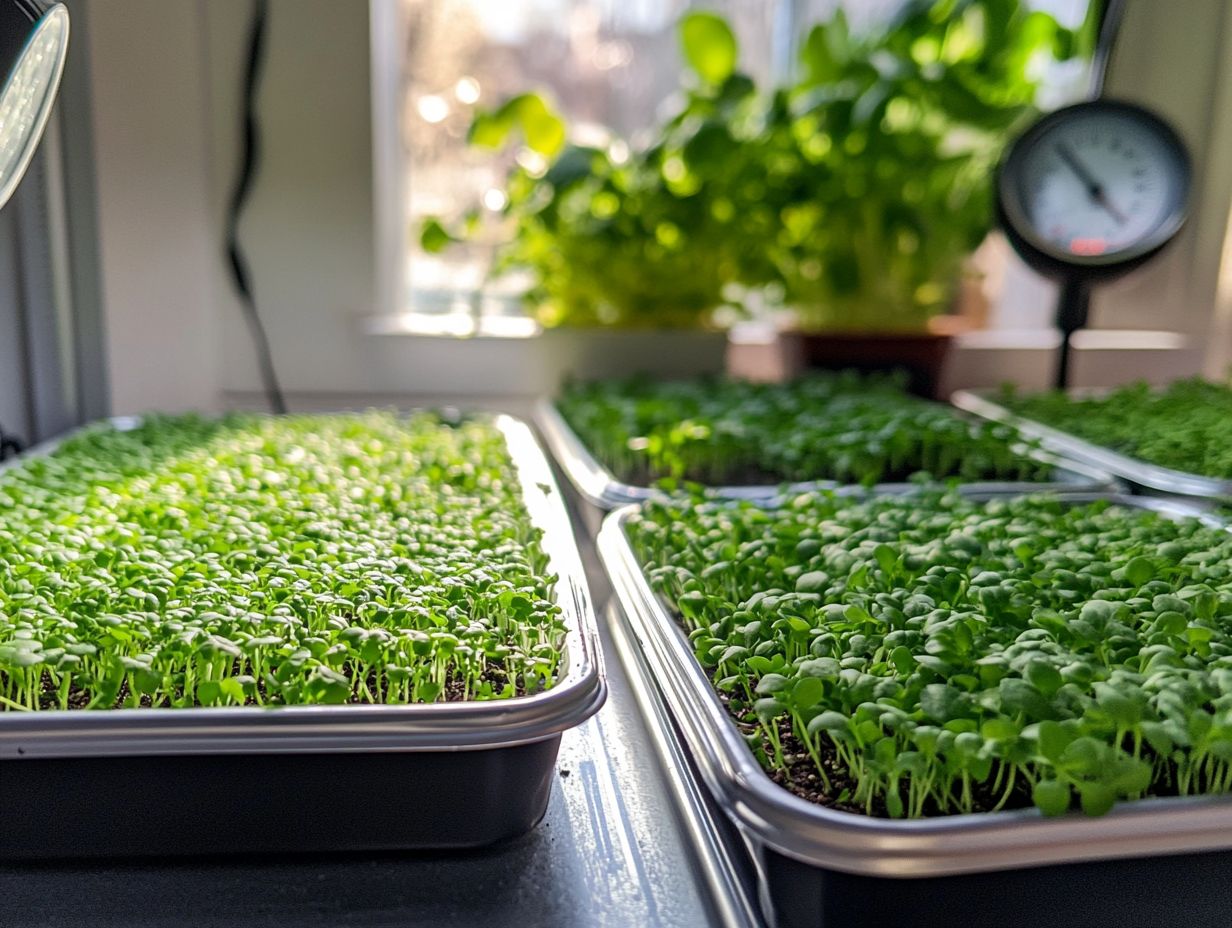
Several factors influence the climate for growing microgreens, including temperature, humidity management, light exposure, and air circulation.
Understanding temperature preferences helps you identify best practices for cultivating various microgreen varieties. For more insights on this subject, check out the role of temperature in microgreen growth. This can be tailored to different climates, whether cold, humid, or sunny.
Temperature, Humidity, and Light
Temperature, humidity, and light exposure are key factors in the growth of microgreens. Maintaining the right levels of these elements optimizes germination rates and nurtures healthy seedlings.
To create the ideal environment, monitor the temperature. Aim for a consistent range between 65 F and 75 F for vigorous growth. Using grow lights for microgreens can be a game changer, especially during shorter days. Ensure your microgreens receive at least 12 to 16 hours of light each day.
Controlling humidity is crucial. It prevents unwanted growth of mold and mildew and promotes quicker germination. A humidifier can maintain moisture levels, but don t overlook proper ventilation to avoid excess dampness.
Incorporating these strategies, including watering techniques, sets the stage for your microgreens to thrive. You’ll enjoy rich flavors and vibrant nutrition, elevating any dish.
Methods for Controlling Climate in Microgreen Growing
You have various methods for controlling the climate in microgreen cultivation. This is especially true when comparing indoor and outdoor environments and their respective moisture levels.
Using tools like heating mats, fans, and humidity trays, you can manage temperature and humidity levels, creating ideal conditions for optimal growth. For more detailed guidance, check out this article on how to use a grow tent for microgreens.
Indoor vs. Outdoor Growing
Indoor gardening offers the remarkable advantage of precise climate control, which outdoor growing cannot match due to unpredictable weather conditions. In your indoor garden, you can use various tools to regulate temperature and manage humidity, ensuring your microgreens flourish.
This ability allows for a year-round growing season, freeing you from seasonal constraints. While indoor setups create ideal environments, be prepared for a significant investment in equipment and energy.
In contrast, outdoor growing lets you benefit from natural sunlight and fresh air, often resulting in richer flavors and larger yields. However, it also introduces challenges such as pest management and fluctuating weather conditions. Those dedicated to optimizing their crop’s potential can enhance microgreen cultivation in either setting.
Tools and Techniques for Maintaining Climate
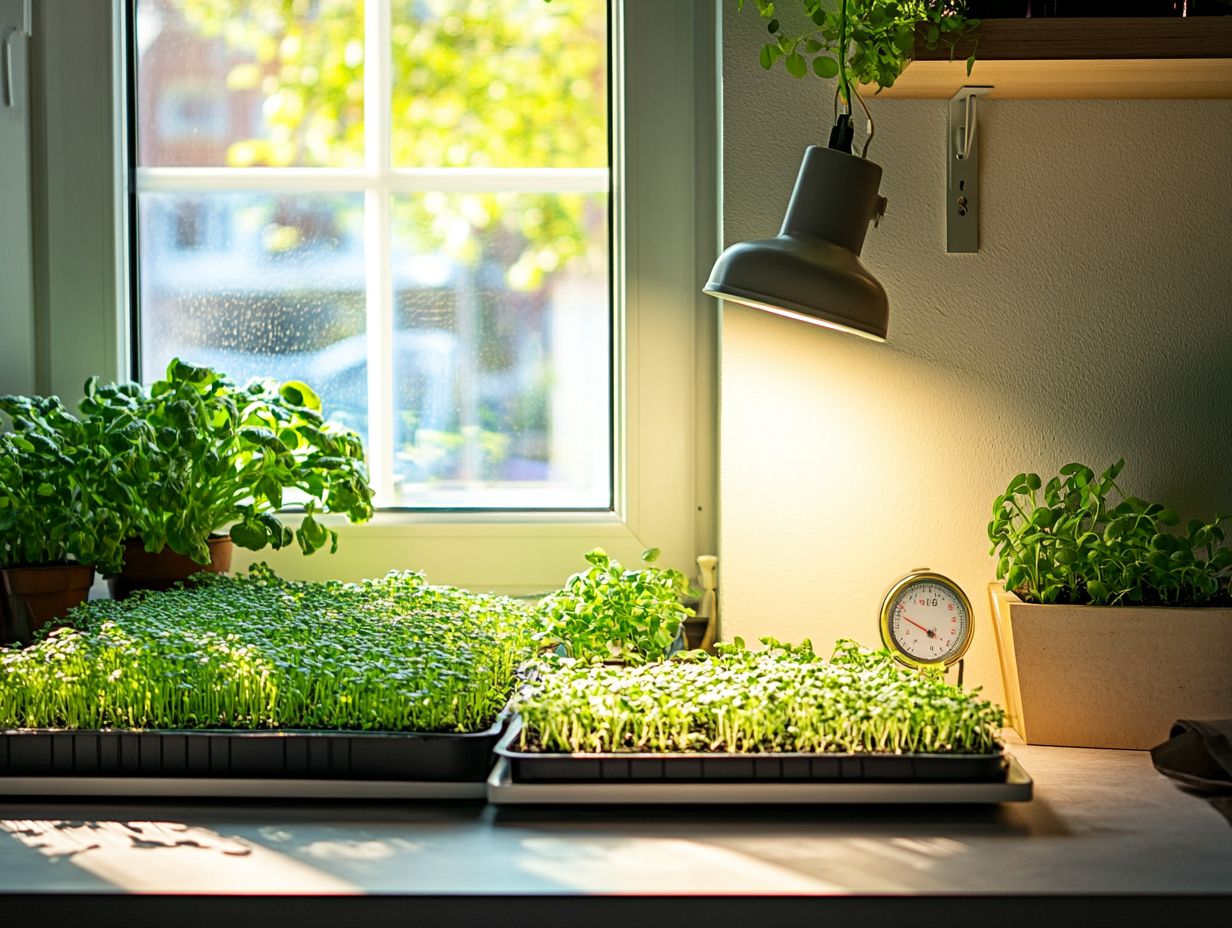
You can employ several tools and techniques to maintain optimal climate conditions for your microgreens. These include heating mats, fans for airflow, and humidity trays for moisture management. Mastering these tools significantly boosts the growth and productivity of your microgreens.
For example, heating mats provide consistent warmth from below, promoting faster germination and strong root development. Fans enhance airflow, preventing stagnant air that can lead to mold growth and unhealthy plants. Humidity trays filled with water regulate moisture levels, ensuring your seedlings get the right hydration without the risk of oversaturation. If you’re interested in advanced methods, check out this guide on how to use hydroponics for microgreens.
Each of these methods fine-tunes the growing environment and nurtures a healthy ecosystem for your microgreens, resulting in healthier, more vibrant plants.
Act now to optimize your microgreens for the best flavors!
Tips for Successful Microgreen Growing with Climate Control
To grow thriving microgreens, follow guidelines focused on climate control. Ensure enough light exposure, maintain optimal moisture levels, and understand the temperature preferences of different microgreen varieties.
By paying attention to these factors, you’ll increase your chances of success in growing microgreens.
Best Practices and Common Mistakes to Avoid
Monitor moisture levels, control temperature, and manage light exposure. Avoid pitfalls like overwatering and insufficient light to keep your plants healthy.
Strike a balance among these important areas. Regularly check the soil’s dampness; soggy conditions can cause mold, while too little water can stunt growth.
Temperature regulation is vital. Keeping your environment within the ideal range of 65-75 F is essential, as extremes can hinder sprouting.
Providing ample light is essential. Aim for 12-16 hours of bright, indirect sunlight or use grow lights to supercharge photosynthesis and enjoy lush, nutrient-packed microgreens!
By following these best practices and avoiding common mistakes, you can cultivate a bountiful harvest. Using systems like the Hamama system can improve your growing environment.
Frequently Asked Questions
What is climate control and why is it important for microgreen growing?
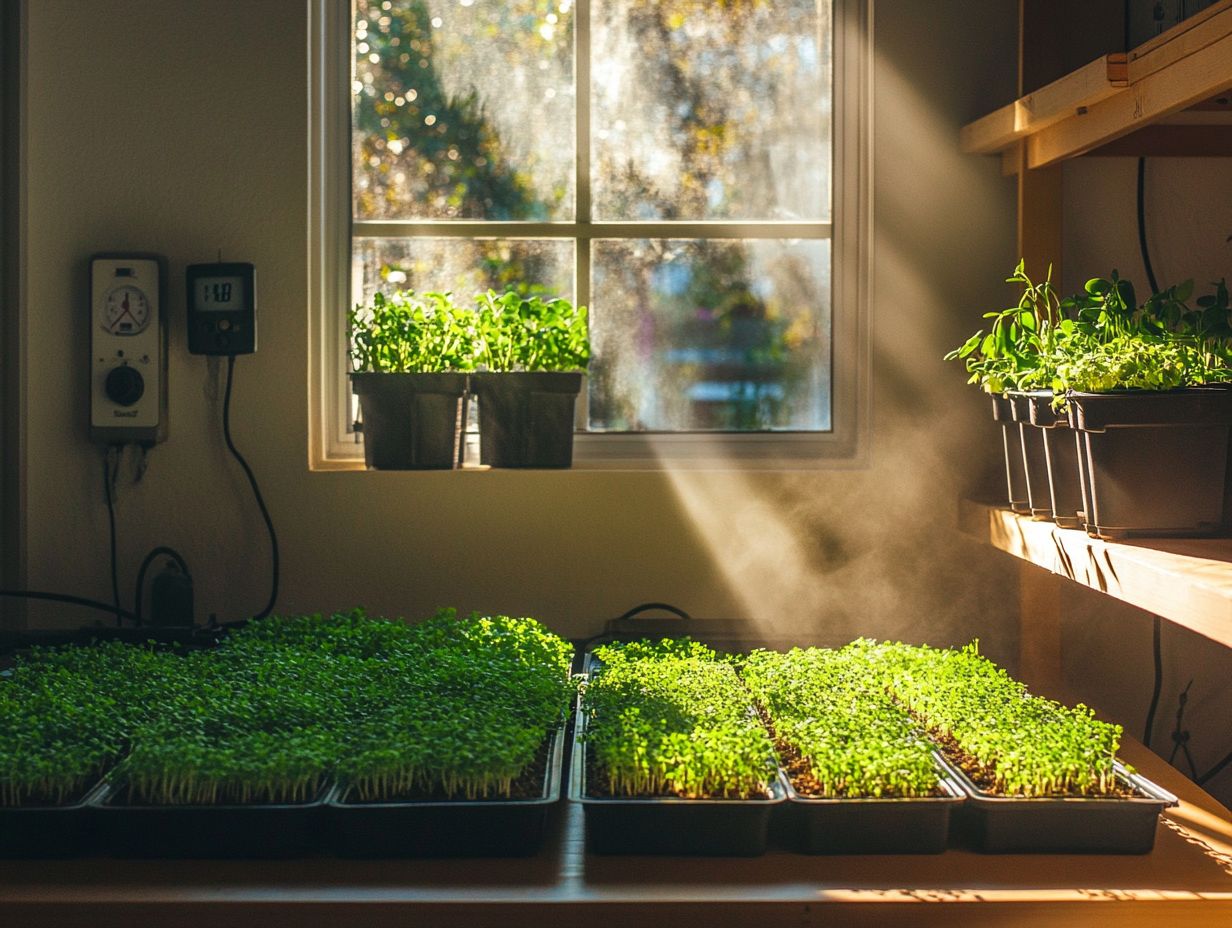
Climate control means adjusting the temperature, humidity, and airflow in your growing area. It’s crucial because the right climate conditions can promote optimal growth and prevent diseases.
How do I use climate control for my microgreen growing setup?
The first step is to choose a suitable location for your growing area, such as a greenhouse or a room with proper ventilation. Then, use tools like thermometers, fans, and humidifiers to monitor and adjust the climate as needed.
What are the ideal climate conditions for microgreen growing?
The ideal temperature range for microgreens is between 60-75 F, with a humidity level of 50-60%. Good air circulation is also important to prevent mold and mildew growth. However, different types of microgreens may have specific temperature preferences, so it’s best to research for each variety.
For example, certain varieties thrive in humid climates, while others prefer dry climates or even cold climates.
Can I use natural methods to control the climate for my microgreens?
Yes, you can. Opening windows or using shade cloths can help regulate temperature and light. You can also use natural humidity-regulating methods like misting the plants or placing humidity trays of water in the growing area to maintain proper soil moisture.
How can I troubleshoot climate control issues in my microgreen growing setup?
If your microgreens are not growing as expected, it could be due to climate control issues. Check your thermometer and humidity levels to ensure they are within the recommended range. You can also use a hygrometer to measure the moisture levels in the air and adjust accordingly.
Proper temperature control and humidity management are key to ensuring healthy seedlings and maximizing nutrient absorption, especially when learning how to use hydroponics for microgreens.
Are there any advanced tools or techniques for climate control in microgreen growing?
Yes, there are various advanced tools and techniques available, such as automated systems that regulate temperature, humidity, and lighting. You can also invest in climate-controlled growing chambers or use specialized equipment like foggers or CO2 controllers for optimal conditions, which can enhance plant health and improve germination rates of your vegetable seeds.


